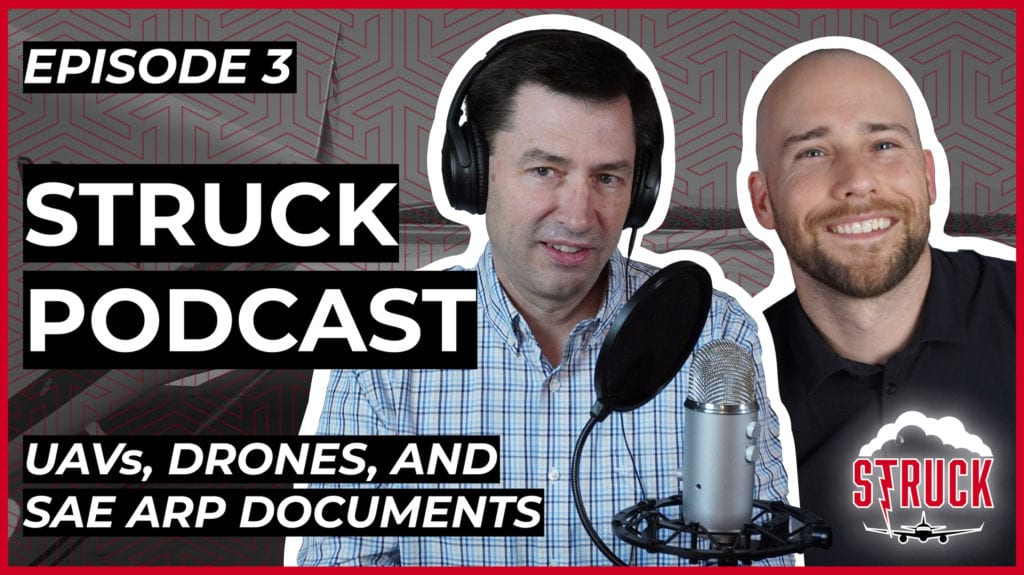In episode three, we discuss some of the industry standards in testing aircraft lightning protection, SAE documents 5414B, 5412B and 5416A, and much more.
Learn more about Weather Guard StrikeTape segmented lightning diverter strips. Follow the show on YouTube, Twitter, Linkedin and visit us on the web. Have a question we can answer on the show? Email us!
Podcast: Play in new window | Download
Transcript:
Dan: Welcome back. This is episode three of the Struck Podcast. I’m your co-host
Dan Blewett and I’m joined here by lightning protection and aviation expert Allen Hall. Allen how are you doing?
Allen: Great dan how are you?
Dan: I’m doing well. The quarantine is in full force. I’m not leaving my home except for a little bit of exercise and some very haphazard shopping. I guess but how are you guys holding up?
Allen: Well everybody’s home obviously. So the college is being done online and the local public school should be switching over to some sort of quasi online classroom hopefully next week. So the kids are gonna start some sort of school which would be good because they’re definitely not going back until earliest is May 4th. So we’re about a month away from that.
Dan: Yeah and I was listening to another podcast this morning and one of the co-hosts she said you know my kids go to expensive private schools and she said it’s just it’s just not going well with the online learning. She’s really not been pleased. She said it’s just a poor experience so far and disorganized and granted I mean it’s not to point any fingers to anyone, this is a tough situation for teachers to grab all their stuff and suddenly go online, but you know I think it’s really just growing pains but she was bringing that up. They were talking about whether college students will get refunded or anyone will get any kind of tuition reimbursement. She said you know like we understand the situation, but at the same time not only are they not getting in person teaching but they’re also just not really getting a great experience in general.
Allen: Yeah the thing we noticed was the room and board obviously got waived for in this case my son goes to Union College and they’re on a trimester system. So they were just about to start their last trimester and the room aboard has obviously been waived because there’s nobody on campus. But the yeah curriculum part we’re still paying for and I think at least at the college level it’s probably a little bit better at because they’ve been doing things like that for a while. A lot of things are online there but in the public schools it doesn’t tend to be that way. So they’ve got to change the way they deliver the curriculum and that that’s a lot of work to do. You know when you’re in front of a board talking in front of 20 odd kids that’s one way. But if you’re trying to give something audio, visual, presentable via zoom typically it’s a much different format to present information. So I can see why schools will be struggling with that. And I know that’s here what they’ve been doing is the teachers have been sending out essentially an email a day saying here are some things you can read or here are some activities you can do here’s some research you can do just to keep everybody active. It’s not required, no one’s getting graded on it, but it seems like the vast majority I would say probably 80% plus of the local kids are actually doing it. And the parents seem to be overseeing a lot of that obviously. But you know at least there’s some learning going on. We’re not just sitting at home watching YouTube or whatever the kids are doing watching tick tock probably.
Dan: Yeah it’s hard. I mean it everyone was just thrown for such a loop and there’s gonna be growing pains you know. And teachers work so hard. It’s just a lot of transition I’m sure for them. All their curriculum just thrown into chaos.
Allen: Right to change track right now. Well I’m curious to see how this is gonna work – if they’re gonna try to bring all the kids online at the same time so you got 20 kids coming into a quote-unquote Zoom classroom whatever that would look like. But we’re telling our kids hey it’s something that we’re gonna have to just work through. It may not be the best situation but at least you’re getting some learning in and taking it for what it is. It’s better than then in the alternate right now so have a positive attitude about it.
Dan:Yeah absolutely I mean so many layoffs. So speaking of which, the aviation industry is struggling right now. So it sounds like based on a couple of news reports they’re serving they’re down about 80% you know typical traffic. So what’s your take on the current state of the airline industry?
Allen: Well I’ve been reaching out to some of my acquaintances that are in the airline industry and support the airline industry. Roughly what it sounds like now is, in at least the United States, 75 to 80 percent of the flights are essentially either shut down or empty depending on the airline. International flights have essentially stopped for the most part. A lot of airplanes have been parked across the country. I saw a list this morning of all the different places and it has a long list. I think was in the Washington Post where they had listed all the places that airplanes have been parked at. The the consensus right now is that they haven’t really… In 2001, I’ll give you the comparison, in 2001 and 9/11 when that happened obviously they shut down all flights for several days in the United States. No airplanes. Everybody had just immediately land. So wherever they were is where they landed. And then when it picked back up again, there was a hesitancy for people to go traveling again and the airlines really suffered and they started putting airplanes in the desert. Basically mothballing them. Permanently mothballing them or selling them for scrap. That happened just because it took a longer time for the airlines to recover. In this case it looks like airplanes are pretty much in flying shape. They’re just parked somewhere. There’s going to be some changes though. A week ago it would seem like all the airplanes are going to be back online pretty quickly. And then this week the attitude changed somewhat which is disappointing. But I think what they’re talking about is that the domestic flights, at least in the United States. are gonna pick up relatively quickly. It’s gonna be the international routes which means the bigger airplanes, I’m gonna use Boeing as an example here, but like the triple 7 and the 67 and the 787, which do a lot of the long-haul carrying and are the bigger airplanes, are not going to be as popular. Just because there’s gonna be fewer international routes. So those airplanes may get parked and the older ones may get parked permanently, which is disappointing really disappointing.
Dan: So as far as Boeing’s fleet goes because you know for me as sort of someone new to this industry, how do they break down as far as you know all the call numbers: 727, 737. Which ones are the ones that are mostly for domestic flights?
Allen: 737.
Dan: 737. So yeah the max was gonna be the big new workhorse if it hadn’t had all of its issues
Allen: It still will be. Yeah it’ll be the workhorse. It’s mostly driven by I think Southwest Airlines is probably the largest purchaser maybe Ryanair over in the UK there’s a largest purchaser of 737s but it’s such a workhorse. It’s like the 8319 8320. They’re such workhorse airplanes. They’re great domestic airplanes. You can pack them pretty full. They’re about the right size to get in and out of a lot of different airports. The engines have been upgraded over time so they’re really fuel-efficient. Those airplanes gonna be hard to replace with anything else. Those are the right planes for the right time. You’re gonna see a little more I think, based on fuel prices being so low, hopefully the airlines that have cash reserves are buying options on fuel. So they’re buying fuel at probably a 75% discount right now with all the oil prices as low as they are. So what you do is you say hey I’m gonna buy a bunch of fuel at this price and it just saves you buying fuel when it’s right back at normal normal prices. So Southwest Airlines was notorious for doing that probably 10-15 years ago. They had bought a ton of fuel options when prices were right and it saved them hundreds and hundreds of thousands of dollars a quarter. The numbers were astounding because fuel prices are such a big driver in the airline’s profitability so when if they can gamble correctly on fuel prices, it just is a huge revenue source for them. And Southwest had done a good job many years ago. Now I wonder if other airlines have learned from that original Southwest experience. If they have cash sitting around, they going to start picking up some of those options and make themselves a little more profitable as they go forward. Obviously it sounds like a lot of the European countries are going to be providing some funds to the airlines. British Airways is probably one, obviously in the United States it’s going to be American Airlines maybe United. We’re all gonna be looking. Southwest sounds like they’re going to be asking for some money to try to tide them over and keep the employees quasi-paid. There’s a lot of furloughs right now in the aviation industry. Hopefully they’re short-lived that’s the goal. Or if everybody can come back to work in a couple of weeks there and get going. But we’ll see how it plays out. The next couple of weeks are going to be crucial to see how long the financial people can keep the airlines running.
Dan: Yeah. Well it’s an interesting problem because as you hear some of the out cries here in the US about you know you’re bailing out these companies but like we need money in our pocket. And yes that’s true but if you don’t bail out some of these companies you don’t get your job back. And then you don’t have long-term money. So it’s like yeah .
Allen: You’ve got two problems right? You’ve got a short-term pain and a long-term pain. Which one are you gonna weight it towards. There is no proper answer when you’re in the middle of this. It’s all a guess. Anybody that tells you they’re right–that’s just a complete guess in my opinion. Just based on track records of other times we’ve been through similar situations, the outcomes have been substantially different than the initial predictions. So I’m not listening too hard to the early predictions here. Let’s see how it plays out. The resiliency of these economies is such that I would be surprised–there’s going to be a lot of big changes in airlines. Obviously airlines that were in trouble like the airplane company that was over in and flying the UK and Belfast in particular closed just as the coronavirus thing started. But they were in financial trouble before it. The ones that are right on that edge right on that bubble may go away, but the bigger airlines like British Airways are going nowhere. Those national airlines, like Air France, is going nowhere.Those airlines are gonna be around for a while.
Dan: Yeah for sure. So within all these different industries there’s little niche industries that are maybe doing quite fine or just hang on and or maybe really hitting their stride. A lot in the technology sector, obviously Zoom is one of them, Slack is another, but but General Atomics will release their new remotely piloted aircraft the sky Guardian ARPA in April. So what’s you take here on some of these drone companies? And are they a little more insulated from this?
Allen: They are because they’re serving a different market they’re serving a military market primarily and then sort of a Border Patrol market. Because they’re drones. They’re a remotely piloted aircraft and they’re full of sensors and instrumentation. They have really grown over the last 10 years I’d say. So when I first remember hearing some noise out of General Atomics, it was 15 years ago now. They were starting to make drone type airplanes. They were fairly simple at the time and they’ve evolved a lot. And they’ve become– just because of the track record–they have had good service life and success doing the missions that they were designed for. So as those missions were successful they pushed the envelope and kept developing and developing and developing obviously. And now the airplanes– RPAs is what General Atomics is calling it– are getting used sort of worldwide. Now the thing about those aircraft is they’re not small they’re about the size of a private business jet airplane. They’re fairly good sized airplanes and then they’re flying in civilian airspace a lot of times. It isn’t like they’re flying over the Gulf of Mexico or their Atlantic Ocean or somewhere where if they fall out of the sky it doesn’t matter. If they’re flying over populated areas, they’re having to qualify those aircraft for essentially FAA type regulations. They’re having to demonstrate that the aircraft can fly in icy conditions, that they can tolerate lightning strikes, that they can fly in pretty much any environment that a typical piloted aircraft can fly in. That’s a big draw. If they can make that leap and–I think they have. Global Hawk had done it a long time ago. Global Hawk tends to fly much much higher than the Predator or Sky Guardian airplanes do. But if they can demonstrate that the aircraft is consistently able to stay in flight even when it does–and those remotely piloted aircraft or drone aircraft have taken a number of lightning strikes if you look back over the last 10 years or so they’ve taken a lot of strikes. If they come back and are in good working order, that helps sell the next one. Because when you lose them they’re not cheap either so when you lose one Yeah the power plants are expensive, all the electronics that are stuffed up inside the nose of them are expensive. So when you lose one it is financially a lot of money. But in today’s world where they are flying all over the place you cannot have them fall in some populated civilian area. That would blow up the industry. That would be a real negative in the industry. And then you find a lot of regulators weren’t saying essentially what would happen is that they’d force some kind of–like supersonic aircraft-they force them over the oceans to fly in certain restricted areas. So they got to get this right. And it sounds like General Atomics has been doing a lot of that work. The press and PR for them has said they’ve done low-level lightning testing on the aircraft. That’s an interesting little bit of a test. We do that on private jets, big airplanes, it’s part of the certification process for mainly flight control systems. Systems that if they went wrong the airplane would would crash. So in an airplane–what we call a low-level aircraft test–so it’s a low level test where you’re actually applying lightning like impulses into the aircraft and you’re monitoring where those impulses go and and how much energy ends up on the electrical equipment inside the aircraft and you’re taking measurements inside of there. Those tests run typically about two weeks or so to run. It’s a human intensive endeavor to run those tests. But at the end of those tests you have a really good sense of what the lightning is going to do to the aircraft. And General Atomics has performed that test. I think the group down at NTS in Pittsfield Mass actually had performed that test. NTS has a lot of experience in that I think they really did the initial development for a lot of those tests. So if they had passed those tests that means that the Sky Guardians are pretty durable aircraft which is good. Which is what they should be doing. It’s really what they should be doing.
Dan: Yeah. So I want to talk a little bit more about testing. If you’re an engineer working on these projects and you get to this phase where you’re like okay this thing needs to be adequately protected, where do they go? I know there’s SAE documents out. There’s three you know the most prominent ones.
Allen: The Holy Trinity.
Dan: The Holy Trinity. Could you quickly go over the three big SAE documents. The ARP5414B, the 51412, and the 5416, right?
Allen: Yes so that’s the Holy Trinity so 5412, 5414, and the 5416. 5412 is the lightning environment, which defines the amount of voltage or current that you would experience in a lightning strike and provides guidance about each of the waveforms that you would typically apply and where where you would apply them to the aircraft. 5414 is a zoning document.
Dan: Let me back you up. So 5412 when you’re talking about waveforms, what does that mean specifically?
Allen: The shape of the current or the shape of the voltage you would apply. In particular with the current how much energy would be in that current pulse. So if we’re doing destructive testing like we’re putting a direct strike on an aircraft wing tip or something like that. The 5412 would tell you the peak current and the amount of energy that would be in that current pulse. There’s actually either three or four pulses that get applied during a single lightning test. It all happens at one time even though there’s three or four different –well there’s usually just three currents that are being applied simultaneously there’s another one at at at the end –but that defines either the average current, the amount of coulombs, which is a measure of current over time or the action integral which is a measure of basically instantaneous energy or power that’s dissipated. Those things defined are in 5412 so that we have some consistency in the testing. Also in today’s world in the analytical side and the modeling you want to have defined waveforms, current waveforms, and voltage waveforms, that you’re applying either in a test environment or in a computational environment. Because you’re really hoping the goal is that you can take your aircraft part or take your aircraft design to any of the different places that do testing around the world or analysis around the world and get the same result out. And that’s what drives the 5412 and that you’re applying the right amount of energy and that the energy is representative of what we have either measured–and mostly measured on the ground–or is representative that something’s gonna happen at flight. So you don’t apply too little but you also want to apply way more than what would actually occur because you’re gonna put protection on the aircraft which you don’t need. Which is just dead weight.
Dan: So is the 5412 more for testing centers or is it something an engineer needs to pick up?
Allen: It’s good for the engineer to pick up to get a sense of what’s going on. So if you’re just an arm’s length away from it where you’re just designing a part you’re not going to be testing it necessarily. It’s good knowledge to know so you can understand what’s going on when the lightning person writes a test plan or shoots off a test report you have a sense of what they’re talking about. 5412 will do that. There’s also some environmental things in there where the data comes from. And I think it’s in the backend of that document where they have discussions of the different lightning– the rate of rise of the current, the decay of the current, the coulombs in the lightning strike, all that sort of data that it’s based on it’s known in the back of it too. So it sort of has a research paper-ish kind of feel to the backend of it. But the heart from an engineering standpoint are the requirements for the currents and voltage waveforms. That’s where things matter.
Dan: Gotcha and then the 5414?
Allen: 5414 is the lightning zoning document. That defines where we think lightning is going to initially attach to the aircraft and where lightning will continue to attach. So you have the initial attachment areas, what we call lightning zone 1, 1A, 1B. Lightning zone 1A is where lightning will likely initially attach but with low hang on. Those tend to be places like the nose of the aircraft where there’s an initial attachment but it’s not gonna stay there longer as the aircraft moves.
Dan: Yeah going 500 miles per hour.
Allen: Yeah all right it’s gonna move toward the back of the airplane, so that’s lightning zone 1A. Lightning zone 1B would be like the tail cone where lightning would attach there and stay there for the whole duration of the lightning event. That’s in the document. Lightning zone 2 is like the fuselage of the aircraft where the lightning channels sweep as air comes through. The lightning channel stays stationary with the aircraft moves forward and the lightning attaches along different parts of the fuselage as the aircraft moves. And then lightning zone 3 is where we don’t think lightning or where there’s a low probability of lightning attachment. So there’s definitions and there’s some nice pictures in there of different kinds of aircraft from turboprops like King Airs and Bonanzas to private jets like citations.
Dan: I’m gonna chuckle. You said some nice pictures and I just got like this image of you know just some some real nice pictures like a coloring book. But these are obviously very technical drawings I’m sure but…
Allen: They are technical drawings and when I say nice pictures…
Dan: It’s helpful.
Allen: Its helpful, yeah you know a picture says a thousand words. That’s exactly what it is. If you try to describe what’s going on there in words it’d take you forever.
Dan: Yeah it’d be a mess.
Allen: Yeah it’s hard when you see in–especially if you’ve done light any protection as long as some of us have–when you see a new airplane design. Like oh yeah well lightning’s gonna attach here, its gonna attach there. But you try to describe it to somebody and it’s nearly impossible. Why do you say that? Well because I’ve seen a lot of aircraft strikes. That’s why I say that. And this is what we see so here you go. So it’s more of a graphical interface than a text interface I think that’s how I would describe it.
Dan: Yeah that’s important. I mean so much of this stuff is really hard to digest and then you’re reading through these technical papers and then you see a photo and you’re like oh okay now it comes full circle. And then the last one the 5416.
Allen: 5416 which is the testing document. Again the testing document has the procedures to run a number of tests on either components or full aircraft. So it has the low-level aircraft tests described in it–there’s actually two different ways of running that test–but they’re in that document. And then testing of very specific components. If you’re testing a windshield, there’s a test for non-conductive things like a windshield. There’s testing for conductive components. There’s testing describing if you’re testing fuel tanks or where there would be fuel contained inside this container. So they have special mixtures –hydrogen oxygen mixtures–they put behind the test article to simulate fuel vapor. There’s high-voltage testing in there, which testing radomes is the one I use it for for the most part. And there’s some other testing like model tests. So if you do have a new aircraft design model, new aircraft design or shape or configuration. If you want to try to figure out where lightning attaches to it you can actually run a high voltage test on a model and and record where the simulated lightning attached to it. And that becomes part of your lightning zoning. So the 5416 is sort of where the rubber meets the road in terms of tests. That is a set of procedures that the FAA has blessed to say yep this is how you do it. But it relies upon 5414 to determine where the lightning zones are and then 5412 for the energy and amplitudes of current are going to be applied. So they worked… Yeah it is like the Holy Trinity. They work together. To make a lightning test or analysis you’re going to rely on all three of those things.
Dan: Yeah so if you’re a new engineer or you’re on a new aircraft, like this is something you’re gonna have to review as your career just continues to progress. And then they update these what every three, four, or five years? Something like that?
Allen: Yeah they’re refreshed. I think they call them refreshed or reissued. So they review them every couple of years to make sure the content is still good. All the SAE documents tend to be that way. Where they’ll go back and look at them to make sure that they haven’t got obvious major typos. Or the state of the art hasn’t changed or there’s not some new technology that we need to incorporate into documents. Yeah so every couple of years though they’ll get refreshed and renewed so they get you for another 80 bucks whatever it is per document.
Dan: And then where do you feel like the cutoff is– so kind of going back to drones before we wrap up here–where do you feel like the cutoff is in most points where someone’s just not gonna probably put lighting protection onto a new drone or a really small aircraft? Obviously if it has human beings in it even it’s a tiny one you’re gonna want something in there. But where do you feel like the cutoff is where someone’s like ahh we’re just not gonna bother.
Allen: That’s a good question. You know when we started doing the UAVs 15 or20 years ago, the big push there was we don’t need lightning protection. We’re not gonna be struck by lightning. There’s this story, because I was sitting in a meeting in which this happened, what are you know about lightning protection? Well we’re not gonna do anything about lightning protection. Well why not? Why wouldn’t you do that? He says well because we have meteorologists that are sitting in the in the command center and we’re monitoring the weather and we’re going to keep ourselves–I don’t know the number at the time–five miles away from any sort of thunderstorm event. And yeah, sure, okay, that sounds great I suppose. But you just realize that that’s not gonna be very effective. The data has said, history has shown that when you say that, you probably have lowered your probability of taking a lightning strike, but you haven’t eliminated it. If you go back and look at the data after that, becauseI was curious to see how that would all play out, and it played out like I thought it was gonna play out. Which was one of two things: either they had to run the mission and the mission involve flying through clouds, and it was just like Apollo 12. It’s the same thing as Apollo 12 which there wasn’t any thunderstorm in the area, but you were it. You flew into the charged cloud and you initiated the lightning strike. So that was happening– that was the first one–the second one was you can get struck in clear air. And everybody’s seen that who’s been on the ground long enough. I’ve been around thunderstorms where there’s just a bolt out of the blue. Those things happen and you don’t have to be in the cloud to get struck. So both of those things were happening and it was taking down some of the drones. So then the realization is, that life cycle happens, like oh dang. We lost that aircraft. What’s going on? Well maybe if you do some minimal lightning protection this stuff won’t happen and then you start seeing everybody start to processes and do it. So I don’t know if there’s an area–it’d have to be something relatively small. Obviously if it fell out of the sky no one would care about and it can’t have anybody on it. I know the new regulations for part 23 have sort of changed the mix which concerns me a little bit. And we’ll see how it plays out. But to me some of the things we do for lightning protection are so intuitive just to make aircraft work, that why wouldn’t you do them. I think that’s where I come from is some of them just need to be done.
Dan: Yeah that makes sense. And obviously with aircraft causing strikes, the bigger they get the more that the need intensifies for sure. You know if you bought a little DTI one you know it’s 500 bucks. It’s just gonna get fried to a little crisp if that were to happen. But that one’s also a lot less likely to cause one itself that’s right.
Allen: It’s based on size, right? It’s based on size. The bigger they get, the more likely they’re gonna get struck.
Dan: Yeah absolutely. Well Allen, good talk today about you know tons. A little deeper today on some of the technical aspects, but you know for like a young engineer listening that’s a lot of technical stuff to wade through. So I think that’s probably helpful as they try to finish their projects and you know sort out what they need to do to qualify these and get them out the door.
Allen: Yeah it’s a lot of homework. You’ve got to do your homework in aerospace, no doubt about it.
Dan: Absolutely so if you’re new or if you’re a recurring listener thanks for being here! We appreciate it. So definitely subscribe, we’re on iTunes, we’re on Spotify, anywhere you listen to podcasts. You can watch this on video on YouTube, you can also catch clips. If you’re interested in just trying to grab a little quick sound bite they might help you with your project. We’re going to be chopping all of these up into just helpful you know quick hits so you can come back have a easy sort of user experience. If you need to grab like hey what’s in the 5412? You can easily grab it out of our YouTube channel. So look forward to that and as always check out our website www.weatherguardaero.com and if you need anything just shoot us a message. Allen, another good episode! Appreciate it!
Allen: Yes thanks, Dan.
Dan: Thank you, we’ll see you here next time!
11:40 Will Drone Companies Be Able to Stay in Business During Covid-19?
13:45 More on UAVs
17:32 Allen Explains ARP5412 Waveforms
19:41 Uses of ARP5412 Form
20:44 Describing the ARP5414 Document and Lightning Zones
23:13 The Tests Included in the ARP5416 Document
25:38 Do UAVs Need Lightning Protection?












